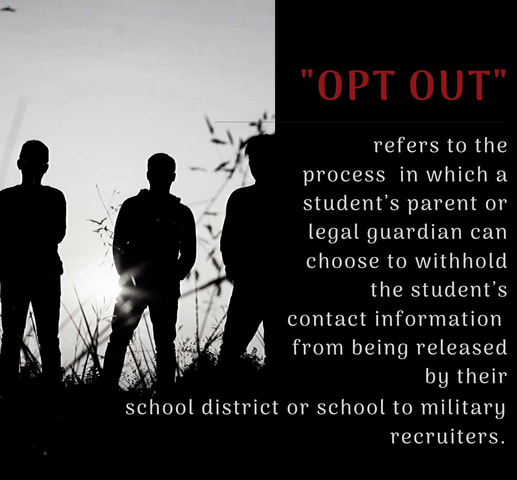
From National Network Opposing the Militarization of Youth | Original Article
WHAT IS IT?
The Joint Advertising Market Research Studies (JAMRS) is a series of projects that seek to collect and buy information about the American public with the intent of formulating marketing and advertising strategies to aid in the military recruitment effort. It is in the service of the Department of Defense, as well as other government bodies, to a lesser extent.
The database created from this information contains data on about 30 million of young Americans 16-25 years old1. This includes “name, date of birth, gender, mailing address, e-mail address, race and ethnicity, telephone number, high school name, graduation date, Grade Point Average, college intent, military interest, field of study, and the ASVAB Test score.”2 Until 2006, it also collected Social Security Numbers. The New York Civil Liberties Union filed and subsequently won a lawsuit to prevent this from continuing to happen, and to reduce the time limit the data would remain in the system from five years to the current amount: three years.3
Aside from sending out polls to young people and “influencers” (meaning adults that are connected and can influence youth from 12 to 21 years old), JAMRS buys information from the DMV, College Board, the ASVAB test, and the Selective Service system, and others.4
WHY IS IT IMPORTANT?
Framed within the larger debate on online privacy, JAMRS and its data collection is an affront to young people’s privacy rights; this detailed information is gathered almost exclusively without their or their parent’s knowledge and consent, and the mechanisms for opting out are not clearly communicated to them.
This data is then used to shape recruitment strategies for the military, targeting young people of certain races or ethnicities. This is reflected by the overrepresentation of black and latinxs in the military compared to US society as a whole.5 People of certain socio-economic backgrounds are also targeted, as is evidenced by the different benefits the armed forces place front and center of their reasons to enlist: scholarships for college, job training, and eventual VA benefits.
The marketing, advertising, and recruitment strategies can often paint a misleading picture of what being in the US Armed Forces is like, glossing over the physical, psychological, and emotional dangers that enlisted members are subject to.
WHAT CAN YOU DO?
- If you’re 18 years old, you can opt out by filling this form (courtesy of Project YANO) and send it out to the following address (the JAMRS headquarters), your information will be inaccessible to recruiters and remain sealed in the suppression file. If you’re younger than 18, ask your parents to fill out the form and send it to the following address.
Joint Advertising Market Research & Studies (JAMRS)
4800 Mark Center Drive, Suite 06J25
Alexandria, VA 22350-4000
- If you are a parent, guardian, or know a person between 16 to 21 years of age, you can give them the opt-out form. If they have expressed an interest in joining the military, you can also direct them to the Winning the Peace website, which contains information about the military often missing from recruitment material.
- Spread the word! Tell other people in your school, other parents and guardians or write to your local or school paper. Most people are unaware of the information that JAMRS has collected on them, and deserve to at least make a choice on whether or not that is something they want the US military to have.
- Hand out opt out forms, or ask school authorities (teachers, the principal, counselors) to hand them out.
Sources
1 https://www.nyclu.org/en/information-about-jamrs-database
2 https://www.nyclu.org/en/joint-advertising-market-research-studies-jamrs
3 Idem
4 Idem
5 https://www.cfr.org/article/demographics-us-military
